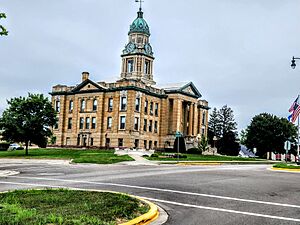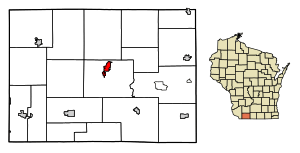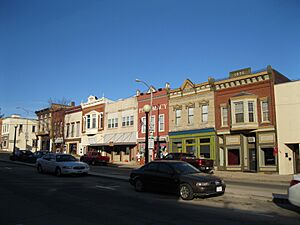Darlington, Wisconsin facts for kids
Quick facts for kids
Darlington, Wisconsin
|
||
|---|---|---|

Lafayette County Courthouse
|
||
|
||

Location of Darlington in Lafayette County, Wisconsin.
|
||
| Country | ||
| State | ||
| County | Lafayette | |
| Area | ||
| • Total | 1.65 sq mi (4.27 km2) | |
| • Land | 1.65 sq mi (4.27 km2) | |
| • Water | 0.00 sq mi (0.00 km2) | |
| Elevation | 869 ft (265 m) | |
| Population
(2020)
|
||
| • Total | 2,462 | |
| • Density | 1,494.8/sq mi (577.1/km2) | |
| Time zone | UTC-6 (Central (CST)) | |
| • Summer (DST) | UTC-5 (CDT) | |
| ZIP codes |
53530
|
|
| Area code(s) | 608 | |
| FIPS code | 55-18875 | |
| GNIS feature ID | 1563718 | |
Darlington is a city in Wisconsin, and it's the main town of Lafayette County. In 2020, about 2,462 people lived there. The city is surrounded by the larger Town of Darlington.
Contents
History of Darlington
The first home in Darlington was a log house built by Jamison Hamilton in 1836. He planned the village, first called Avon or Centre, in 1847. Darlington officially started in 1849, but it was known as Centre for many years. The first town meeting happened on April 3, 1849.
The first store opened in 1848. More stores, including a hat shop and a hardware store, opened a few years later. The first drug store was started by J. Collins and Dr. Blair, who was the first doctor in the city. The first school opened in the winter of 1850 with 15 students. Religious services were first held in Jamison Hamilton's barn in 1851. The Mineral Point Railroad reached the town in 1856, which helped the village grow.
In 1857, Darlington became the county seat, meaning it was the main town for Lafayette County. The courthouse was built using county money. The town of Centre officially changed its name to Darlington in 1869. This new name honored Joshua Darling, who bought the land in 1850 with help from J.M. Keep and J.B. Lynde. The first streets were mapped out in June 1850.
The streets were named after the wives of the town's important men. For example, Minerva was the wife of James G. Knight, the first village president. Mary was the wife of Josepheus Driver, an early businessman. Harriet, Lucy, Louisa, and Cornelia were also names of wives of key founders and planners.
The Ringling Brothers Circus Connection
Alfred T. Ringling, one of the famous Ringling Brothers, lived in Darlington when he was 20. He worked as a harness maker and put on small shows for local students and citizens. One popular act involved him balancing a plow on his chin while four strong farmers lifted it.
Two brothers from Darlington, Joe and Alfred E. "Butch" Parson, also loved the circus. Joe Parson bought a bison and started a show called "The Great Palace Show." Alfred Ringling worked as a ropewalker in the Parson Brothers' shows in the early 1880s.
When the Ringling Brothers (Alfred T., John, Charles, and Otto) started their own circus in 1884, they invited the Parson Brothers to join them. The Ringlings had their own band, with Al playing the bass drum and John leading on the cornet. The Parsons joined in 1887. Joe Parson performed horseback riding and high-wire stunts. Butch Parson managed the concession stand, selling snacks like popcorn and lemonade.
The brothers worked well together for a while. However, the Ringling Brothers eventually felt the Parsons were making too much money from the concession stand. In 1906, the Parsons made about $30,000 in profit. The Ringlings wanted to run the concessions themselves. After many letters, the Ringlings ended their business relationship with the Parsons in 1908. Even though their partnership ended, the Parson Brothers became very wealthy from their concession business.
Geography and Climate
Darlington covers about 1.34 square miles of land.
Darlington's Weather
Darlington has a warm-summer humid continental climate. This means it has warm summers and cold, snowy winters. The hottest temperature ever recorded in Darlington was 107°F (42°C) in July 1936. The coldest temperature was -41°F (-41°C) in January 1951.
| Climate data for Darlington, Wisconsin, 1991–2020 normals, extremes 1901–present | |||||||||||||
|---|---|---|---|---|---|---|---|---|---|---|---|---|---|
| Month | Jan | Feb | Mar | Apr | May | Jun | Jul | Aug | Sep | Oct | Nov | Dec | Year |
| Record high °F (°C) | 59 (15) |
71 (22) |
84 (29) |
93 (34) |
104 (40) |
104 (40) |
107 (42) |
102 (39) |
100 (38) |
91 (33) |
79 (26) |
71 (22) |
107 (42) |
| Mean daily maximum °F (°C) | 27.3 (−2.6) |
31.8 (−0.1) |
44.3 (6.8) |
57.7 (14.3) |
69.4 (20.8) |
78.9 (26.1) |
82.2 (27.9) |
80.5 (26.9) |
73.8 (23.2) |
60.9 (16.1) |
45.5 (7.5) |
32.6 (0.3) |
57.1 (13.9) |
| Daily mean °F (°C) | 17.8 (−7.9) |
21.6 (−5.8) |
33.6 (0.9) |
46.2 (7.9) |
57.8 (14.3) |
67.8 (19.9) |
71.0 (21.7) |
69.0 (20.6) |
61.1 (16.2) |
49.0 (9.4) |
35.7 (2.1) |
23.8 (−4.6) |
46.2 (7.9) |
| Mean daily minimum °F (°C) | 8.4 (−13.1) |
11.5 (−11.4) |
22.9 (−5.1) |
34.7 (1.5) |
46.1 (7.8) |
56.7 (13.7) |
59.7 (15.4) |
57.5 (14.2) |
48.4 (9.1) |
37.2 (2.9) |
25.8 (−3.4) |
15.0 (−9.4) |
35.3 (1.9) |
| Record low °F (°C) | −41 (−41) |
−39 (−39) |
−33 (−36) |
−1 (−18) |
20 (−7) |
30 (−1) |
39 (4) |
29 (−2) |
21 (−6) |
−2 (−19) |
−20 (−29) |
−33 (−36) |
−41 (−41) |
| Average precipitation inches (mm) | 1.31 (33) |
1.43 (36) |
2.02 (51) |
3.89 (99) |
4.18 (106) |
5.29 (134) |
4.22 (107) |
4.36 (111) |
4.10 (104) |
2.80 (71) |
2.35 (60) |
1.69 (43) |
37.64 (955) |
| Average snowfall inches (cm) | 11.3 (29) |
9.2 (23) |
4.6 (12) |
1.0 (2.5) |
0.6 (1.5) |
0.0 (0.0) |
0.0 (0.0) |
0.0 (0.0) |
0.0 (0.0) |
0.6 (1.5) |
2.2 (5.6) |
6.2 (16) |
35.7 (91.1) |
| Average precipitation days (≥ 0.01 in) | 6.4 | 6.2 | 6.2 | 9.4 | 10.3 | 10.1 | 7.9 | 7.0 | 8.2 | 7.2 | 6.2 | 6.3 | 91.4 |
| Average snowy days (≥ 0.1 in) | 4.8 | 3.8 | 1.7 | 0.5 | 0.1 | 0.0 | 0.0 | 0.0 | 0.0 | 0.2 | 1.1 | 3.6 | 15.8 |
| Source 1: NOAA | |||||||||||||
| Source 2: National Weather Service | |||||||||||||
Population Information
| Historical population | |||
|---|---|---|---|
| Census | Pop. | %± | |
| 1880 | 1,372 | — | |
| 1890 | 1,589 | 15.8% | |
| 1900 | 1,808 | 13.8% | |
| 1910 | 1,808 | 0.0% | |
| 1920 | 1,798 | −0.6% | |
| 1930 | 1,764 | −1.9% | |
| 1940 | 2,002 | 13.5% | |
| 1950 | 2,174 | 8.6% | |
| 1960 | 2,349 | 8.0% | |
| 1970 | 2,351 | 0.1% | |
| 1980 | 2,300 | −2.2% | |
| 1990 | 2,235 | −2.8% | |
| 2000 | 2,418 | 8.2% | |
| 2010 | 2,451 | 1.4% | |
| 2020 | 2,462 | 0.4% | |
| U.S. Decennial Census | |||
Darlington's Population in 2020
In 2020, Darlington had a population of 2,462 people. Most residents (75.1%) were White. About 15.6% were from other races, and 7.9% were from two or more races. About 23.7% of the population identified as Hispanic or Latino.
Darlington's Population in 2010
In 2010, there were 2,451 people living in Darlington. There were 994 households, and 623 families. About 89.5% of the people were White. About 12.1% of the population was Hispanic or Latino.
About 30.9% of households had children under 18. The average age in the city was 38.7 years old. About 23.5% of residents were under 18, and 18.4% were 65 or older. The population was almost evenly split between males (50.1%) and females (49.9%).
Economy of Darlington
Darlington is the county seat, so its economy mainly involves local government. It also has many businesses that support farms and make food, especially related to Wisconsin's dairy industry. Some big employers in the city include the Lafayette County government, a Mexican cheese and cream plant, and Wisconsin Whey Protein. Because of jobs in the dairy industry, more Hispanic and Latino immigrants have moved to Darlington since 2000.
Education in Darlington
Darlington has its own school district called Darlington Community Schools.
Darlington High School serves students in grades 9 through 12. In the 2020-2021 school year, there were 245 students and about 21 full-time teachers. This means there were about 11.6 students for every teacher. The school's mascot is the Redbird.
Darlington Elementary-Middle School teaches children from pre-kindergarten up to 8th grade. In 2020–2021, this school had 680 students. The student-teacher ratio was about 14.3 students per teacher.
Fun Things to Do in Darlington
Darlington's Main Street Historic District is a special area listed on the National Register of Historic Places. Darlington is known as the "Pearl of the Pecatonica" because the Pecatonica River flows through the town. People used to collect clams from the river to make pearl buttons.
The Pecatonica River Trails Park is a city campground with 24 spots right by the river. There's also a paved path for walking and biking that follows the river through town. Many people enjoy canoeing and fishing in the Pecatonica River. Darlington has a public swimming pool that is open every day from June to August.
Riverside Park has a softball field, a basketball court, and a playground. Black Bridge Park offers sand volleyball courts, a soccer field, and a flag football field. The community also has a Veterans Memorial Park and Festival Grounds.
Darlington is close to Yellowstone Lake State Park, where you can swim, camp, fish, and boat. The Darlington Golf & Country Club has a nine-hole golf course. The Cheese Country Recreational Trail is over 50 miles long and is popular for ATV riders. It goes through nearby towns like Monroe, Belmont, and Mineral Point.
During the summer, you can watch Friday night stock car races and visit the county fair. A Cinco de Mayo celebration is held near the river in May. Darlington hosts the annual Canoe Fest in June, which includes canoe races, live music, a carnival, and a parade. The Lafayette County Fair is in July and features livestock displays, a midway, and concerts. Pecatonica Valley Antique Days happen in September, and Holiday Open Houses are in November. There's also an annual Holiday Parade on the first Saturday in December.
Notable People from Darlington
- William Armstrong, Wisconsin legislator
- John J. Boyle, U.S. Attorney
- Homer Dwight Chapman, educator
- Charlie Dougherty, MLB player
- Alex Erickson, football player
- Mark Helpsmeet, activist
- Henry S. Magoon, U.S. Representative
- U.S. Army General Francis Marshall
- Harry C. Martin, state senator and mayor
- John Morrow, U.S. Representative
- Sylvan Muldoon, author
- Philo A. Orton, Wisconsin legislator and judge
- Charles F. Osborn, Wisconsin legislator, judge, and mayor
- Sylvester W. Osborn, Wisconsin legislator and postmaster
- David Stuart Rose, mayor of Darlington and later Milwaukee
- John Sheldon, Wisconsin legislator
- Penelope Trunk, author and journalist
See also
 In Spanish: Darlington (Wisconsin) para niños
In Spanish: Darlington (Wisconsin) para niños



